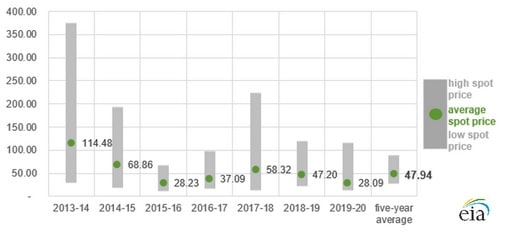New England Wholesale Electricity Prices Dropped by 40 Percent During 2019-20 Winter: EIA

New England’s average wholesale electricity prices dropped by 40 percent to $28 per megawatthour during the 2019-2020 winter from $47 per megawatthour in the previous winter, according to a June 10 report from the U.S. Energy Information Administration.
Natural gas-fired generators set the price of electricity more often compared with previous winters because of the use of new, more efficient combined-cycle plants and supply from existing generators. Power prices for heavy load hours averaged about 40 percent lower consistent with the reduction of average wholesale gas prices, which helped moderate electricity prices in New England this past winter.
- Low natural gas prices, warmer-than-normal temperatures, lower demand, and reduced need to operate expensive generators contributed to the lower prices.
- The New England grid operator reported daily temperatures during the peak months from December through February averaged about 3 degrees Fahrenheit above the average temperatures, compared to the same period last winter.
- Cumulative winter heating degree days in New England from November through March dropped by 5 percent, compared to the most recent 10-year average.
- Winter demand peaked at 19,033 megawatts on Dec. 10, 2019, which is 8.2 percent lower than the previous winter peak.
- The total value of the energy market from December through February was $1 billion, about $600 million less than the same period last winter.
- Average electricity prices remained historically low despite the decommissioning of the 677-megawatt Pilgrim Nuclear Power Station in May, resulting in a 13.6 percent decrease in nuclear energy output.
- Natural gas accounted for 49 percent of average total generation and renewables accounted for 22 percent of generation during the peak winter months of.
- The natural gas wholesale price dropped by about 40 percent and the average daily generation from natural gas increased about 4 percent despite a 6 percent decrease in average system peak loads due to lower spot prices.
EnerKnol Pulses like this one are powered by the EnerKnol Platform—the first comprehensive database for real-time energy policy tracking. Sign up for a free trial below for access to key regulatory data and deep industry insights across the energy spectrum.
ACCESS FREE TRIAL